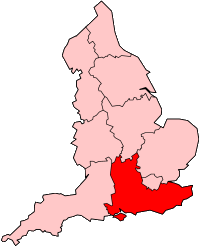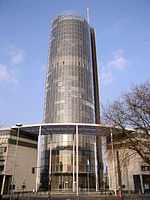
Rye House Power Station is a 715 MW combined cycle gas turbine (CCGT) power station located near Rye House railway station in Hoddesdon, Hertfordshire.

Brunswick Wharf Power Station was a coal- and oil-fired power station on the River Thames at Blackwall in London. The station was planned from 1939 by Poplar Borough Council but construction only started in 1947 after the Second World War. It was decommissioned in 1984, and the site was redeveloped.

Grain Power Station is a 1,275 megawatts (1,710,000 hp) operational CCGT power station in Kent, England, owned by Uniper. It was also the name of an oil-fired, now demolished, 1,320MW power station in operation from 1979 to 2012.

West Ham Power Station was a coal-fired power station on Bow Creek at Canning Town, in east London. It was often referred to informally as Canning Town Power Station.

Little Barford Power Station is a gas-fired power station just north of the village of Little Barford in Bedfordshire, England. It lies just south of the A428 St Neots bypass and east of the Wyboston Leisure Park. The River Great Ouse runs alongside. It was formerly the site of two coal-fired power stations, now demolished. The station is operated by RWE.

Great Yarmouth Power Station is combined cycle gas turbine power station on South Denes Road in Great Yarmouth in Norfolk, England, with a maximum output of 420 MW electricity, opened in 2001. It is built on the site of an oil-fired power station, built in 1958 and closed and demolished in the 1990s. A coal-fired power station was built in Great Yarmouth in 1894 and operated until 1961. The station is operated by RWE.

Shoreham Power Station is a 420MWe combined cycle gas-fired power station in Southwick, West Sussex. It was built on the site of the Brighton B Power Station.

Staythorpe C Power Station is a 1,735 MWe gas-fired power station at Staythorpe between Southwell and Newark-on-Trent in Nottinghamshire, England, between the River Trent and Nottingham to Lincoln railway line. The station was handed over to the owner RWE from Alstom Power with full commercial operation being achieved in December 2010. The official opening ceremony attended by Charles Hendry, Minister of State took place on 9 May 2011.

The Tilbury power stations were two thermal power stations on the north bank of the River Thames at Tilbury in Essex. The 360 MW dual coal- and oil-fired Tilbury A Power Station operated from 1956 until 1981 when it was mothballed, prior to demolition in 1999. The 1,428 MW Tilbury B Power Station operated between 1968 and 2013 and was fueled by coal, as well as co-firing with oil and, from 2011, biomass. Tilbury B was demolished in 2016–19. Since 2013 three other power stations have been proposed or constructed in Tilbury.

Ince Power Station refers to two demolished power stations near Ellesmere Port in Cheshire, North West England.

Doncaster Power Station refers to two coal-fired electricity generating stations situated in the centre of Doncaster in South Yorkshire, England. Doncaster A provided electricity to the town from 1900 to 1958, and the B station from 1953 to 1983.

Taylors Lane Power Station is situated in Willesden, north-west London. The first power station on the site, known as Willesden power station, was coal-fired and operated from 1904 to 1972 and was subsequently demolished. Taylors Lane is now an open cycle gas turbine (OCGT) power station built in 1979.

Northfleet Power Station was a coal-fired, later oil-fired, power station on the south bank of the Thames at Northfleet, Kent. Opened in 1963, it was converted to burn oil in 1972, and closed in 1991.
Bold Power Station refers to a series of two coal-fired power stations in Bold near St Helens, Merseyside, North West England. They were closed, decommissioned and demolished between 1981 and 1992, and a housing estate now occupies the site.
Hastings Power Station was a gas turbine power station situated in Hastings in East Sussex, England. It was built on the site of the Broomgrove coal-fired power station. When the power station was completed in 1966 it had two 55-megawatt (MW) gas turbine generating sets; the first set was commissioned in January 1966 and the second two months later in March.
Watford Power Station was a coal-fired power station situated in Watford's Riverside area. The station was built by the Watford Corporation Electricity Department starting with the installation of cables in 1899 with completion around 1900, near the banks of the River Colne. A gas turbine power station was commissioned in 1980.
Ribble Power Station was a coal-fired electricity generating station on the River Ribble in Penwortham near Preston, Lancashire, England. The station was built by the Corporation of Preston to replace a small privately-run generating station in the town. It supplied electricity to Preston and the surrounding area from 1923 until 1976. The station was expanded with new equipment in 1943–47 which remained in operation until the power station was closed in 1976 and was subsequently demolished.
Bromborough power stations are three electricity generating stations that supplied power to industrial and domestic users in Bromborough, Port Sunlight and the wider Wirral area from 1918 until 1998. Bromborough power station provided public electricity supplies from 1951 to 1980. Central power station Bromborough (1918–1998) was originally owned by Lever Brothers and supplied electricity to domestic users in Port Sunlight as well as electricity and steam to industrial users. Merseyside power station Bromborough (1958–1998) was also owned by Unilever and provided electricity and steam at a range of pressures to industrial users in the locality. All three power stations at Bromborough have been demolished.
Stourport power stations were two electricity generating stations that supplied electricity to Stourport-on-Severn, Worcestershire and to the wider West Midlands area from 1927 to 1984. The two stations, A (1927–78) and B (1950–84), were collocated on a joint site adjacent to the River Severn south of Stourport-on-Severn.
The Thornhill power station generated and supplied electricity to the town of Dewsbury and the wider regional area from 1902 to 1982, and again from 1998. The first generating station on the site was owned and operated by the Yorkshire Electric Power Company. Following nationalisation of the British electricity supply industry in 1948 Thornhill power station was operated by a succession of state owned bodies. The power station was redeveloped with new plant in 1915, 1925, 1932–37 and 1950–54. The coal-fired steam station was decommissioned in 1982, and was subsequently demolished. A gas turbine power station on the site was commissioned in 1998.

















